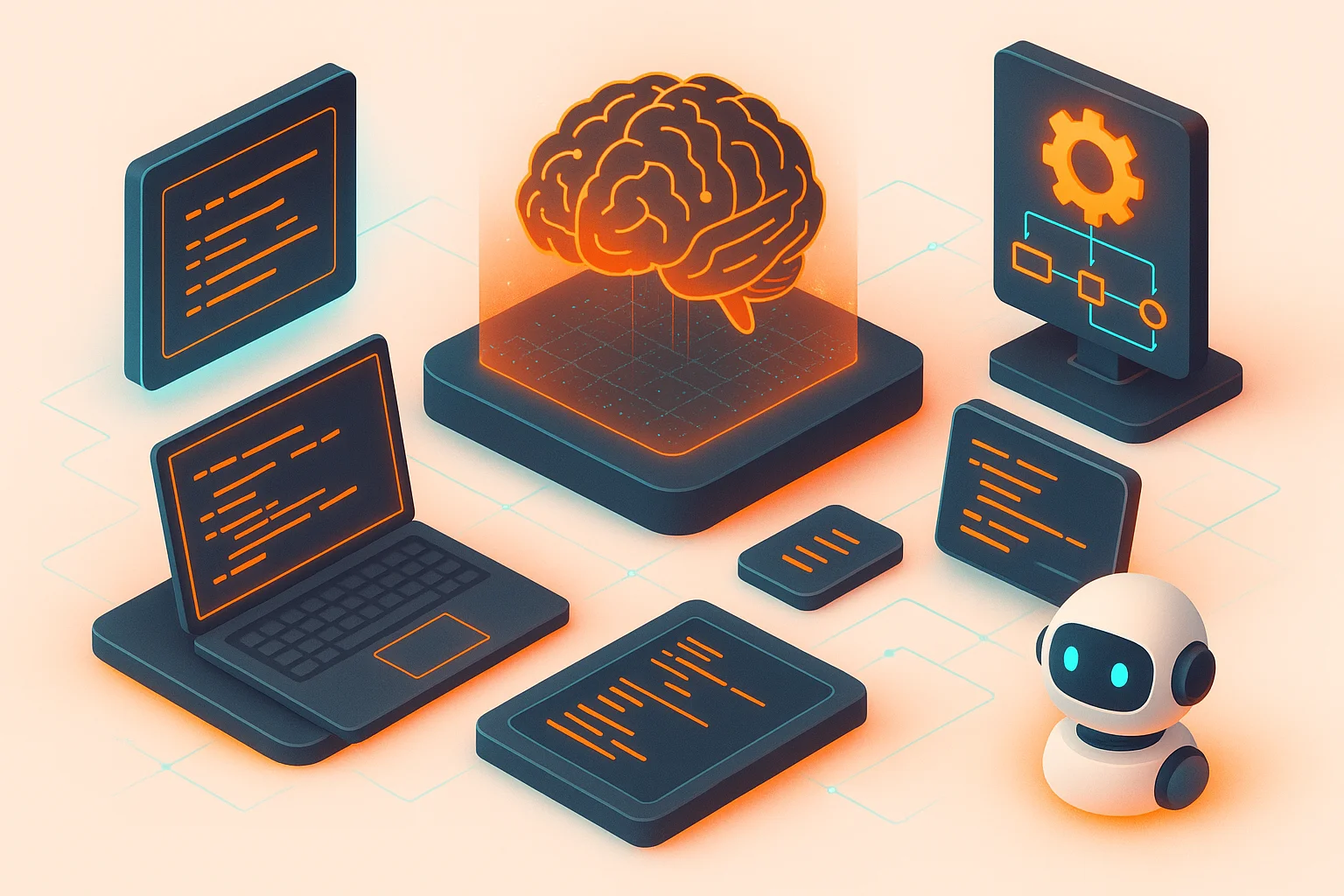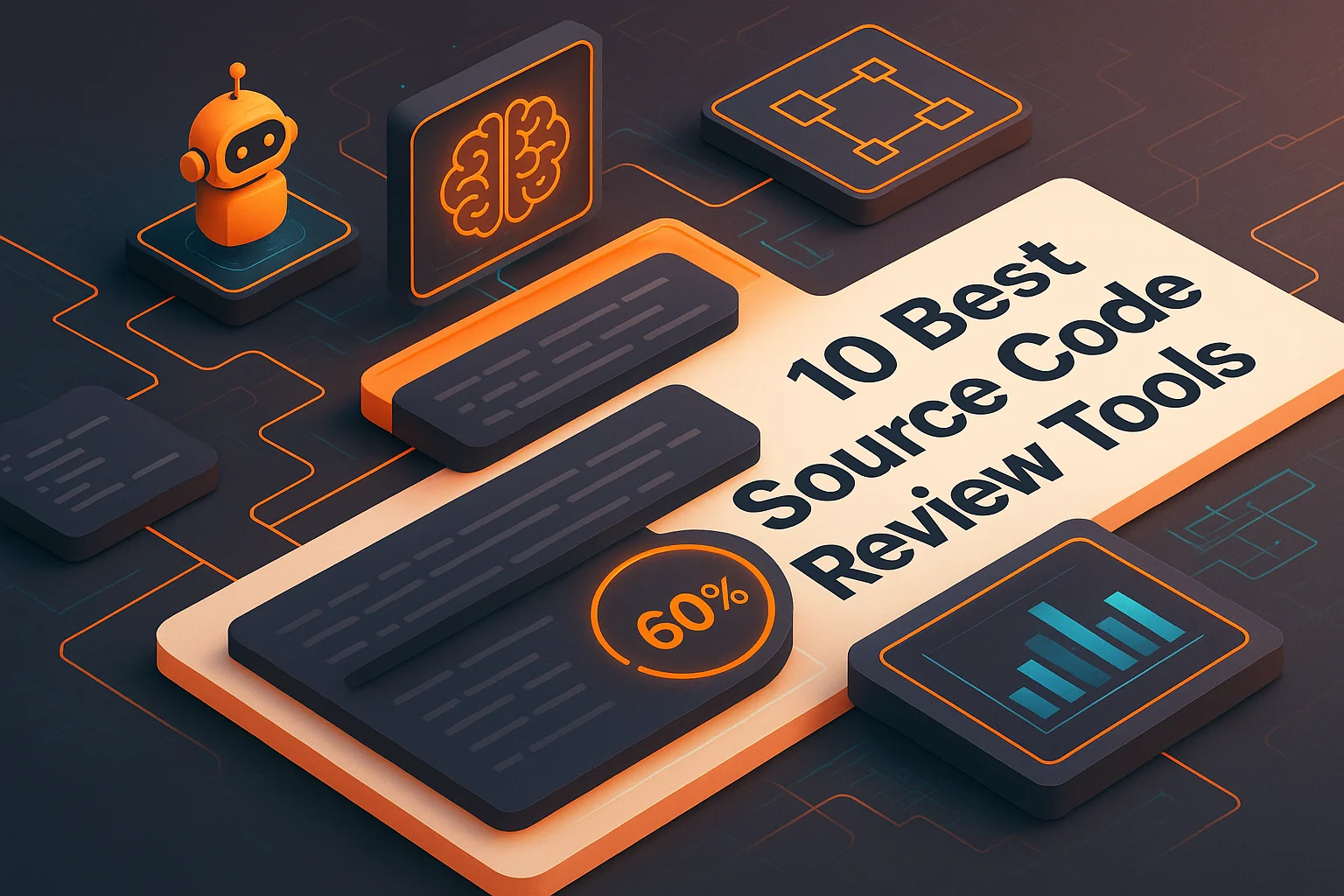How AI is Transforming Code Completion in 2025

AI code completion has evolved from simple autocomplete to intelligent programming assistants that understand context, generate entire functions, and adapt to your coding style. Discover how these tools are reshaping software development in 2025 and what it means for developers and engineering teams.
Key AI Code Completion Insights
- •Productivity Boost: Leading tools increase coding speed by 25-55% for routine tasks
- •Context Awareness: Modern AI understands project structure, dependencies, and coding patterns
- •Quality Considerations: Generated code requires careful review for security and maintainability
- •Learning Curve: Maximum benefit requires learning to write effective prompts and context
The Evolution of Code Completion
Code completion has transformed from simple keyword suggestions to sophisticated AI assistants that can generate entire functions, suggest architectural patterns, and even explain complex code. Understanding this evolution helps developers leverage these tools effectively.
From Autocomplete to AI Assistance
Traditional Autocomplete (2000s-2010s)
Simple keyword completion based on language syntax and local variables
IntelliSense Era (2010s)
Context-aware suggestions with type information and API documentation
AI-Powered Completion (2021+)
Multi-line generation, natural language understanding, and cross-file context
Intelligent Assistance (2024+)
Project-wide understanding, architecture suggestions, and integrated code review
Leading AI Code Completion Tools in 2025
The landscape of AI code completion tools has matured significantly. Here are the standout options:
GitHub Copilot
Strengths: Excellent context awareness, strong multi-language support, seamless GitHub integration
Best For: Teams heavily invested in the GitHub ecosystem
Pricing: $10/month individual, $19/month business
Unique Features: Chat interface, pull request summaries, security vulnerability detection
Cursor IDE
Strengths: Native AI integration, multi-file editing, conversational interface
Best For: Developers willing to switch IDEs for maximum AI integration
Pricing: Free tier available, $20/month pro
Unique Features: AI chat with codebase context, composer for complex changes
JetBrains AI Assistant
Strengths: Deep IDE integration, strong refactoring capabilities, multiple AI model support
Best For: JetBrains IDE users, enterprise development teams
Pricing: Included with JetBrains subscriptions
Unique Features: Integrated debugging assistance, commit message generation
Amazon CodeWhisperer
Strengths: AWS service integration, enterprise security features, free tier
Best For: AWS-centric development teams, cost-conscious organizations
Pricing: Free individual tier, $19/month professional
Unique Features: Security scanning, reference tracking, customizable models
How AI Code Completion Works
Understanding the technology behind AI code completion helps developers use these tools more effectively:
Large Language Models (LLMs)
Modern code completion tools are built on transformer-based language models trained on massive code repositories. These models learn patterns, syntax, and conventions from millions of code examples.
Context Understanding
- Local Context: Current file, function signatures, variable names, and imports
- Project Context: Related files, project structure, and dependency information
- Semantic Context: Understanding of what the code is trying to accomplish
- Style Context: Learning team coding conventions and patterns
Inference and Generation
The AI Completion Process:
- Context Analysis: AI analyzes surrounding code and project structure
- Intent Recognition: Model interprets what the developer is trying to accomplish
- Pattern Matching: AI finds similar patterns from training data
- Code Generation: Model generates contextually appropriate suggestions
- Ranking and Filtering: Multiple suggestions ranked by relevance and quality
Impact on Developer Productivity
AI code completion is measurably improving developer productivity across various metrics:
Speed and Efficiency Gains
Productivity Metrics:
- 📈25-55% faster coding for routine implementation tasks
- 📈40% reduction in time spent looking up API documentation
- 📈30% fewer syntax errors due to AI-generated code quality
- 📈60% faster boilerplate generation for common patterns
Cognitive Load Reduction
AI completion reduces mental overhead by handling routine tasks:
- Syntax Recall: Less need to memorize API signatures and parameter orders
- Pattern Implementation: AI handles common algorithmic patterns
- Error Prevention: Suggestions follow best practices and avoid common mistakes
- Context Switching: Reduced need to leave the editor for documentation
Quality and Security Considerations
While AI code completion offers significant benefits, it also introduces new challenges that teams must address:
Code Quality Concerns
Potential Issues:
- ⚠️Over-reliance: Developers may lose fundamental programming skills
- ⚠️Pattern Copying: AI may perpetuate outdated or suboptimal patterns
- ⚠️Context Misunderstanding: Generated code may not fit specific requirements
- ⚠️Testing Gaps: AI-generated code may lack comprehensive test coverage
Security Implications
AI-generated code requires careful security review:
- Vulnerability Patterns: AI may reproduce security vulnerabilities from training data
- Hardcoded Secrets: Generated examples might include placeholder credentials
- Input Validation: AI suggestions may lack proper input sanitization
- Authorization Checks: Generated code might skip essential security checks
The Critical Role of AI Code Review in the Age of Code Generation
While AI code completion tools have dramatically accelerated development speed, they've also introduced new quality and security challenges. The rapid generation of code without proper review creates a dangerous gap between velocity and reliability. This is where high-fidelity AI code review tools become essential for maximizing the benefits of code generation while maintaining enterprise-grade quality standards.
The Hidden Risks of Unchecked AI-Generated Code
Common Issues in AI-Generated Code:
Quality Problems
- • Inefficient algorithms that work but don't scale
- • Duplicated logic instead of proper abstraction
- • Poor error handling and edge case coverage
- • Inconsistent coding patterns across the codebase
Security Vulnerabilities
- • SQL injection from concatenated queries
- • Exposed API keys in generated examples
- • Missing authentication checks
- • Insecure dependency versions
Research shows that while AI code generation tools can increase coding speed by 55%, they also introduce bugs at a 40% higher rate when used without proper review processes. This creates a paradox: teams code faster but spend more time debugging and fixing issues in production.
How AI Code Review Complements Code Generation
The solution isn't to abandon AI code generation but to pair it with equally sophisticated AI code review. Tools like Propel provide the critical quality layer that ensures AI-generated code meets production standards before it reaches your codebase.
The Synergy of Generation + Review:
Instant Generation
AI code completion generates functions, classes, and logic in seconds
Automated Analysis
AI review tools immediately analyze generated code for issues
Smart Suggestions
Specific improvements for security, performance, and maintainability
Confident Deployment
Ship AI-generated code with enterprise-grade quality assurance
Propel: The Essential Companion for AI Code Generation
Propel is specifically designed to address the quality gap in AI-generated code. Unlike traditional static analysis tools that miss context-dependent issues, Propel's AI understands the intent behind generated code and provides intelligent review that catches the subtle bugs AI generation tools often introduce.
Why Propel is Critical for AI Code Generation Workflows:
Context-Aware Review
- • Understands business logic and architectural patterns
- • Identifies when generated code doesn't fit your standards
- • Catches subtle integration issues across modules
- • Validates API contracts and data flows
Generation-Specific Detection
- • Recognizes common AI generation patterns and anti-patterns
- • Identifies hallucinated APIs or methods
- • Detects overly complex generated solutions
- • Flags security vulnerabilities common in generated code
Real-World Impact: Teams using Propel alongside AI code generation tools report 65% fewer bugs in production and 40% faster overall development velocity compared to using generation tools alone.
Creating a Balanced AI Development Workflow
The most successful engineering teams don't choose between speed and quality—they achieve both by combining AI code generation with AI code review. Here's how to implement this balanced approach:
Optimal AI Development Workflow:
- 1.Generate with AI: Use GitHub Copilot, Cursor, or similar tools for rapid code generation
- 2.Review with Propel: Automatically analyze generated code for issues before committing
- 3.Iterate Quickly: Fix identified issues while context is fresh
- 4.Learn and Improve: Use review insights to write better prompts and generate higher quality code
This workflow ensures that the speed benefits of AI code generation don't come at the cost of technical debt, security vulnerabilities, or maintenance nightmares. Instead, you get the best of both worlds: rapid development with enterprise-grade quality assurance.
Best Practices for AI Code Completion
Maximize the benefits while minimizing risks with these proven strategies:
Effective Usage Patterns
Do's:
- ✅ Use AI for boilerplate, scaffolding, and routine implementations
- ✅ Review and understand all AI-generated code before committing
- ✅ Provide clear context through comments and variable names
- ✅ Test AI-generated code thoroughly, especially edge cases
- ✅ Use AI as a learning tool for new frameworks and patterns
Don'ts:
- ❌ Accept suggestions blindly without understanding the logic
- ❌ Use AI for security-critical or complex algorithmic code without review
- ❌ Rely on AI for architectural decisions or system design
- ❌ Skip testing because the code was "generated by AI"
- ❌ Ignore licensing and attribution requirements for generated code
Team Integration Strategies
Successfully integrate AI code completion across your engineering team:
- Standardize Tools: Choose consistent AI tools across the team for shared learning
- Code Review Focus: Establish specific review criteria for AI-generated code
- Training Programs: Educate team on effective AI prompt writing and usage patterns
- Quality Gates: Implement automated testing and security scanning for AI-generated code
- Knowledge Sharing: Regular sessions to share AI tips, tricks, and gotchas
The Future of AI-Powered Development
AI code completion is just the beginning. Here's what's coming next:
Emerging Capabilities
- Multi-Modal AI: Integration of code, documentation, and visual design
- Automated Testing: AI-generated unit tests and integration test suites
- Performance Optimization: AI-suggested performance improvements and refactoring
- Security Integration: Real-time security vulnerability detection and fixes
- Documentation Generation: Automatic API documentation and code comments
Impact on Software Development
Long-term Changes:
- 🔮Skill Evolution: Developers focus more on system design and problem-solving
- 🔮Faster Prototyping: Rapid iteration and experimentation become standard
- 🔮Quality Democratization: Best practices become accessible to all skill levels
- 🔮New Collaboration Models: Human-AI pair programming becomes prevalent
Frequently Asked Questions
Will AI code completion replace developers?
No, AI code completion augments developer capabilities rather than replacing them. It handles routine tasks, allowing developers to focus on complex problem-solving, architecture, and creative solutions that require human judgment and domain expertise.
How do I choose the right AI code completion tool?
Consider your IDE preference, programming languages, team size, budget, and security requirements. Try free tiers or trials of multiple tools to evaluate which integrates best with your workflow and provides the most relevant suggestions for your codebase.
Is AI-generated code safe to use in production?
AI-generated code can be production-ready with proper review and testing. The key is using high-fidelity AI code review tools like Propel that understand the specific patterns and issues common in generated code. Without proper review, AI-generated code introduces bugs at a 40% higher rate. With tools like Propel, teams achieve both speed and quality, shipping AI-generated code confidently.
How can I improve the quality of AI suggestions?
Provide better context through descriptive variable names, clear comments, and well-structured code. Keep your project dependencies up-to-date, maintain consistent coding styles, and use meaningful function and class names to help AI understand your intent.
Should I use AI code review tools alongside code generation?
Absolutely. AI code generation and AI code review are complementary technologies. While generation tools like GitHub Copilot speed up coding, they can introduce subtle bugs and security issues. AI code review tools like Propel are specifically designed to catch these issues, understanding the patterns and problems common in AI-generated code. This combination gives you the best of both worlds: speed without sacrificing quality.
Experience Next-Gen Code Intelligence
See how Propel's AI-powered code completion and review capabilities can transform your development workflow.


